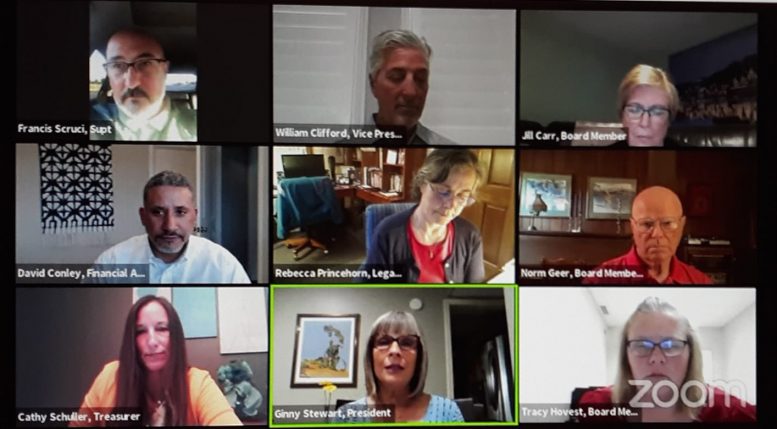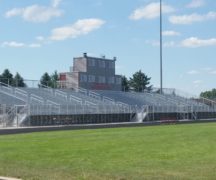By JAN LARSON McLAUGHLIN
BG Independent News
Bowling Green Board of Education agreed to not sit by idly as rural areas of the school district prepare to vote on seceding to other school systems.
The board was advised Tuesday evening to not let rural residents off the hook for taxes owed to the school district – even if they vote to leave.
Faced with the possible loss of $3 million a year due to some residents petitioning to leave Bowling Green City School District, the board voted unanimously to seek a law change that would require township residents seceding from the district to continue paying taxes to the school district for another decade.
The school board and remaining residents of the district have no say in whether or not the petitioned areas vote on Aug. 4 to secede to other neighboring school districts. But those remaining residents will be asked to make up for the $3 million a year loss caused by the exodus.
So Dave Conley, the district’s financial consultant, suggested a law change is needed to protect the remaining residents of the school district.
“The current law does nothing to protect remaining taxpayers,” Conley said. “I believe it’s important for the board to seek a law change.”
At that point in the meeting, school board President Ginny Stewart suggested that the board go into executive session to discuss the new recommendation.
Norm Geer questioned the appropriateness of going into executive session to talk about seeking a change in the law.
Becky Princehorn, attorney for the district, noted that the petitioners had already sued the district once, plus had threatened to sue in a number of correspondences.
“Given the litigious posture of the petitioners,” going into executive session is acceptable, Princehorn said.
When the board members reconvened after executive session, Princehorn was asked if there is any precedent for this type of legislation. She explained that annexation law has been modified to soften the blow to townships losing land to municipal annexations.
“The idea is, I guess, to protect the remaining taxpayers,” Geer said.
If all the petitioned areas leave the BG school district, it will result in “a significant financial hardship” to the district and the remaining residents, Conley said.
There are approximately 1,025 registered voters in the eight petitioned areas. There are about 10,000 taxpayers living in the BG school district.
“The law allows for as few as 513 voters to impact more than 10,000 voters,” Conley said.
“You have an entire community that has no voice” in a decision that will greatly affect them, he said of those citizens not in the petitioned areas.
Conley said the intent of the law allowing petitioners to secede from one district to join another was to allow students to enroll in other districts.
Bowling Green and the other districts being petitioned to join all have open enrollment policies, so the petition effort is “simply unwarranted and indefensible,” Conley said.
“They don’t need to do this to have access to other school districts,” he said.
Because the proposed change in the law could not be penned prior to the Aug. 4 election, Conley suggested that the change be retroactive.
Conley estimated if all the petitioned areas exit BG schools, the district will lose $2 million a year in property taxes, $675,000 in pipeline tax revenue, and $260,000 in income tax revenue.
“It will have a significant financial impact,” Conley said.
The loss of that money would mean the school district would have to turn to the remaining taxpayers to offset the loss, he said.
To make up that amount, the district would need 4.5 mills in new property taxes. For the owner of a home valued at the local median of $162,900, that would mean an additional $265.57 a year.
“Bowling Green wouldn’t be able to just shut off $3 million in expenses,” even if the district lost students through the petition efforts, Conley said.
The potential loss of petitioned areas would be compounded by the financial impact of COVID-19, he added.
“This would just add insult to injury,” Conley said.
Eight petitions will appear on the Aug. 4 ballot. Following is an estimate of the number of voters and parcels covered in each petition:
- Center Township to Elmwood – map is 17 parcels, with 7 voters.
- Center Township to Eastwood – map is 230 parcels, with 90 voters.
- Jackson Township to McComb – map is 13 parcels, with 3 voters.
- Liberty Township to Elmwood – map is 831 parcels, with 397 voters.
- Milton Township #1 to Patrick Henry – map is 61 parcels, with 19 voters.
- Milton Township #2 to Patrick Henry – map is 1,138 parcels, with 467 voters.
- Plain Township to Otsego – map is 116 parcels, with 41 voters.
- Henry County to Patrick Henry – map is 3 parcels.
The following link shows maps and addresses of those areas on the ballot: https://www.co.wood.oh.us/BOE/2020_Aug%20Ballot%20Issues.html
Last month, Conley presented a chart with numbers from the Wood County Auditor’s Office that compared taxes in the districts where the petitioners are asking to join. Based on the median home value and income, those annual taxes are:
- Patrick Henry: $2,942
- McComb: $2,475
- Elmwood: $2,268
- Otsego: $2,236
- Eastwood: $2,137
- Bowling Green: $1,893
Conley pointed out that under current law, the properties leaving Bowling Green’s district will still be required to pay bonds that they remain committed to for BGCS, as well as bonds for the school district that they would be joining.





